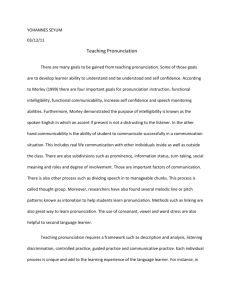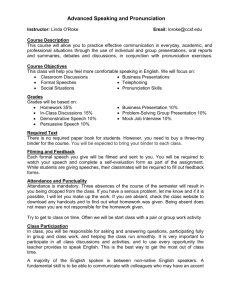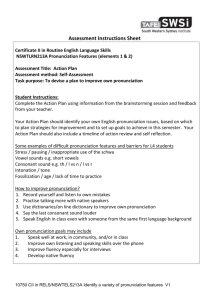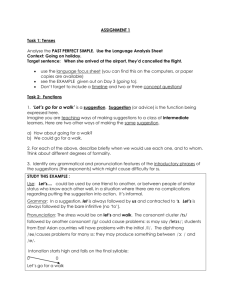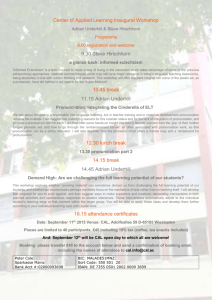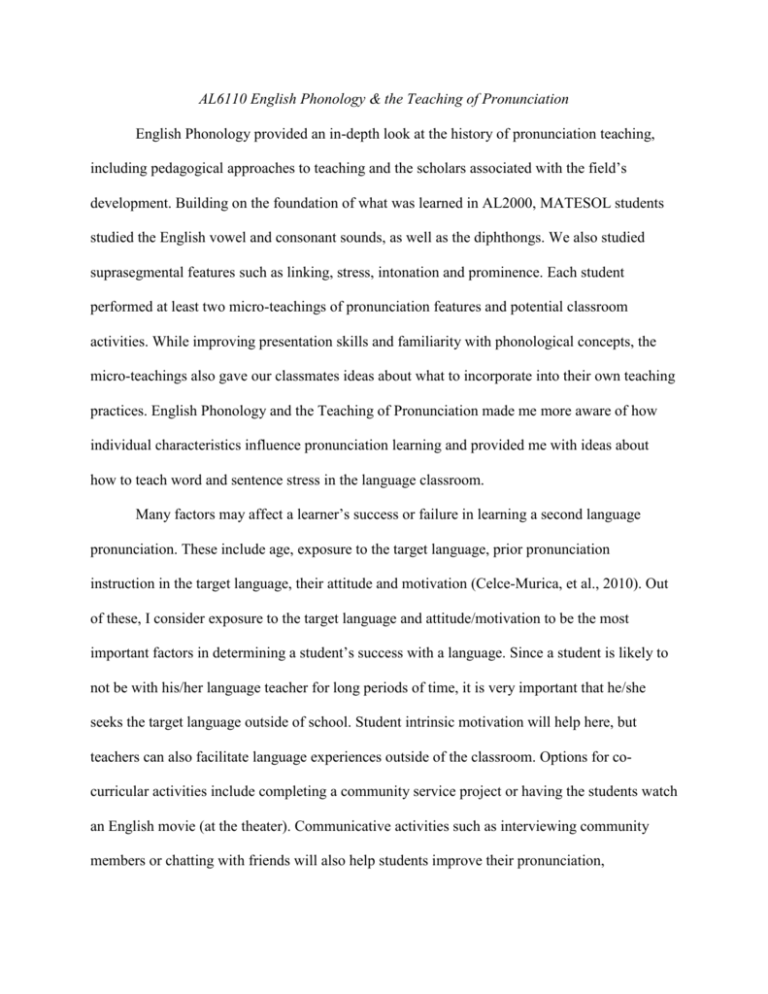
AL6110 English Phonology & the Teaching of Pronunciation
English Phonology provided an in-depth look at the history of pronunciation teaching,
including pedagogical approaches to teaching and the scholars associated with the field’s
development. Building on the foundation of what was learned in AL2000, MATESOL students
studied the English vowel and consonant sounds, as well as the diphthongs. We also studied
suprasegmental features such as linking, stress, intonation and prominence. Each student
performed at least two micro-teachings of pronunciation features and potential classroom
activities. While improving presentation skills and familiarity with phonological concepts, the
micro-teachings also gave our classmates ideas about what to incorporate into their own teaching
practices. English Phonology and the Teaching of Pronunciation made me more aware of how
individual characteristics influence pronunciation learning and provided me with ideas about
how to teach word and sentence stress in the language classroom.
Many factors may affect a learner’s success or failure in learning a second language
pronunciation. These include age, exposure to the target language, prior pronunciation
instruction in the target language, their attitude and motivation (Celce-Murica, et al., 2010). Out
of these, I consider exposure to the target language and attitude/motivation to be the most
important factors in determining a student’s success with a language. Since a student is likely to
not be with his/her language teacher for long periods of time, it is very important that he/she
seeks the target language outside of school. Student intrinsic motivation will help here, but
teachers can also facilitate language experiences outside of the classroom. Options for cocurricular activities include completing a community service project or having the students watch
an English movie (at the theater). Communicative activities such as interviewing community
members or chatting with friends will also help students improve their pronunciation,
particularly if they are focusing on a specific area of improvement. I can also design tongue
twisters or riddles designed to provide learners with practice with a particular sound. These are
different than the typical “Sally sells…” phrases because I will choose just one sound to
concentrate on, not the /s/ and /ʃ/ combined for example.
To help the students remain motivated, I will have each of them set realistic short and
long-term pronunciation goals, such as mastering a particular sound. The time and amount of
practice needed to master particular sounds and suprasegmental features depends on the
characteristics of the learner mentioned above and their intrinsic motivation. This motivation is
encouraged by self-determination and a desire for competence in their language skills (Deci,
1975, in Brown, 2007). I can also help build their intrinsic motivation by providing achievable
challenges through scaffolded activities and a variety of input. Scaffolded activities include
having the students practice with isolated sounds, then combinations of the sounds and then in
natural speech. When the students can start slowly, master a task and witness their own progress,
confidence and a thirst for more learning will take place.
Prior to English Phonology, teaching learners about prominence (word and sentence
stress) never occurred to me because I, as a native speaker, never consciously learned it. Through
my studies in this class, however, I have learned that reasons for word stress include providing
new information, emphasis and contrast. To help my learners understand this type of
prominence, I will first show them written examples of highlighted words in a sentence. For
example: “I said my favorite color was red, not pink.” Pink is the most prominent word here and
receives the most stress. I will have the learners identify why this word is being stressed. Here,
the answer is because it expresses contrast. We will also review examples of providing new
information and general emphasis.
A learner’s first languages may also follow a completely different word stress pattern
than English, such as Hungarian, where the syllabic pattern is always stress/un-stress and restarts
with each word. I will also inform learners that English contains many loan words so the
language itself does not contain a set stress pattern. Words of Germanic origin, like father and
meadow contain first-syllable stress. Knowing the etymology of words is not very important for
most learners, so I will not teach it explicitly though. Through immersion in the target language,
they will begin to detect prominence patterns, as well as from listening to recordings of people
talking naturally. Understanding prominence is important because it helps learners decipher
discourse along with their knowledge of vocabulary.
In conclusion, English Phonology allowed me to practice the teaching of pronunciation
and witness my classmates doing so as well. Teaching and watching my classmates were
extremely helpful because I had never explicitly taught pronunciation before. The class content
and micro-teachings of my peers also provided insights into teaching word and sentence stress
and how individual learner characteristics influence pronunciation learning.
References
Celce-Murcia, M., Brinton, D.M., & Goodwin, J.M. (2010). Teaching pronunciation: A course
book and reference guide. (2nd ed.). New York, NY: Cambridge University Press.
Deci, E. (1975). Intrinsic motivation. In D. H. Brown (2007). An integrative approach to
language pedagogy. (3rd ed.). White Plains, NY: Pearson Longman

